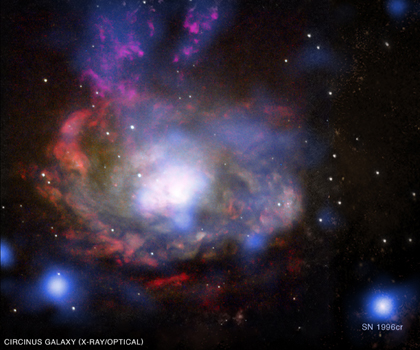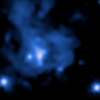For Release: September 25, 2008
CXC Release
 Image Credit: X-ray (NASA/CXC/Columbia/F.Bauer et al);
Image Credit: X-ray (NASA/CXC/Columbia/F.Bauer et al);Optical (NASA/STScI/UMD/A.Wilson et al.)
Press Image and Caption
One of the nearest supernovas in the last 25 years has been identified over a decade after it exploded. This result was made possible by combining data from the vast online archives from many of the world's premier telescopes.
The supernova was first singled out in 2001 by Franz Bauer, then at Penn State and now at Columbia University, who noticed a bright, variable object in the spiral galaxy Circinus using NASA's Chandra X-ray Observatory. Though the source displayed some exceptional properties, at the time Bauer and his Penn State colleagues could not confidently identify its nature.
It was not until years later that Bauer and his team were able to confirm this object was a supernova. Clues in a spectrum from the European Southern Observatory's Very Large Telescope (VLT) led the team to search through data from 18 different telescopes, both in space and on the ground, nearly all of which was from archives. Because this object was found in a nearby galaxy, making it relatively easy to study, the public archives of these telescopes contained abundant data on this galaxy.
The data show that this supernova, dubbed SN 1996cr, is among the brightest supernovas ever seen in radio and X-rays. It also bears many striking similarities to the famous supernova SN 1987A, which occurred in a galaxy only 160,000 light years from Earth.
"This supernova appears to be a wild cousin of SN 1987A," said Bauer. "These two look alike in many ways, except this newer supernova is intrinsically a thousand times brighter in radio and X-rays."
Optical images from the archives of the Anglo-Australian Telescope in Australia show that SN 1996cr exploded between February 28, 1995 and March 15, 1996, nearly a decade after SN 1987A. SN 1996cr may not have been noticed by astronomers at the time because it was only visible in the southern hemisphere, which is not as widely monitored as the northern. Among the five nearest supernovas of the last 25 years, it is the only one that was not seen shortly after the explosion.
SN 1996cr was not detected by other major X-ray observatories in orbit - ROSAT and ASCA - around the time of explosion. Rather, it wasn't until several years later that it was detected as an X-ray source by Chandra (launched in 1999), and has become steadily brighter ever since. Previously, SN 1987A had been the only known supernova with an X-ray output observed to increase over time.
"Supernovas that are close enough to be studied in detail like this are quite rare and may only appear once a decade, so we don't want to miss such an important opportunity for discovery," said Bauer. "It's a bit of a coup to find SN 1996cr like we did, and we could never have nailed it without the serendipitous data taken by all of these telescopes. We've truly entered a new era of `Internet astronomy'."
The data, combined with theoretical work, has led the team to the following model. Before it exploded, the parent star cleared out a large cavity around it, either via a fast wind or an outburst from the star late in its life. Then, the blast wave from the explosion expanded relatively unimpeded into this cavity. Once the blast wave hit the dense material surrounding SN1996cr, the impact caused the system to glow brightly in X-ray and radio emission. The X-ray and radio emission from SN 1987A is fainter because the surrounding material is probably less compact.
Astronomers think that both SN 1987A and SN 1996cr show evidence for these pre-explosion clear-outs by the star doomed to explode. Having two nearby examples suggests that this type of activity could be relatively common during the death of massive stars.
"Not only does our work suggest that SN 1987A isn't as unusual as previously thought, but it also teaches us more about the tremendous upheavals that massive stars can undergo during their lifetime," said co-author Vikram Dwarkadas of the University of Chicago.
SN 1996cr, at a distance of about 12 million light years, will be a compelling target for future work because it is nearby and so much brighter than a typical supernova.
These results will appear in an upcoming issue of The Astrophysical Journal. Other co-authors on this paper include Niel Brandt (Penn State), Stefan Immler (NASA Goddard Space Flight Center), Norbert Bartel (York University, Canada), and Michael Bietenholz (York University and Hartebeesthoek Radio Observatory, South Africa).
NASA's Marshall Space Flight Center, Huntsville, Ala., manages the Chandra program for the agency's Science Mission Directorate. The Smithsonian Astrophysical Observatory controls science and flight operations from the Chandra X-ray Center in Cambridge, Mass.
Media contacts:
Jennifer Morcone
Marshall Space Flight Center, Huntsville, Ala.
256-544-7199
jennifer.j.morcone@nasa.gov
Megan Watzke
Chandra X-ray Center, Cambridge, Mass.
617-496-7998
cxcpress@cfa.harvard.edu
http://chandra.harvard.edu/
and
http://chandra.nasa.gov



